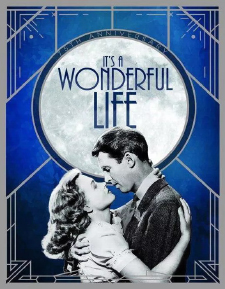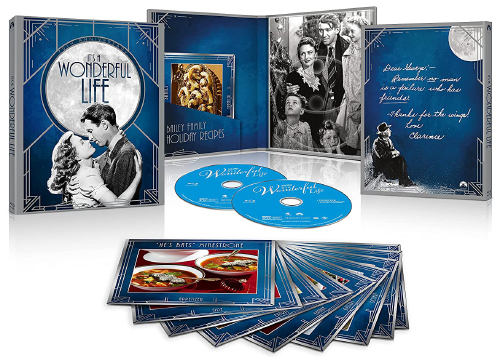It’s a Wonderful Life (Blu-ray Review)

Director
Frank CapraRelease Date(s)
1946 (November 16, 2021)Studio(s)
Liberty Films/RKO Radio Pictures (Paramount Pictures)- Film/Program Grade: A
- Video Grade: A
- Audio Grade: B+
- Extras Grade: B-
Review
In 1974, an oversight caused the copyright for It’s a Wonderful Life to not be renewed, which meant that it fell into the public domain and any TV station could run it without charge. For two decades, the film ran frequently on local stations across America. People who had never seen it before became intrigued with the story of a small-town everyman who gets to see what life would have been like without him. Watching it on TV eventually became a popular holiday tradition.
Based on a story by Philip Van Dorn and directed by Frank Capra, It’s a Wonderful Life is the tale of good-natured, small-town boy George Bailey (James Stewart). After several attempts to leave his native Bedford Falls to travel and see the world fail, George marries childhood sweetheart Mary (Donna Reed), has a few kids, and takes over management of the town’s trusted building and loan association. Meanwhile, town Scrooge Mr. Potter (Lionel Barrymore) repeatedly tries to get control of the bank in a merciless quest for profit. His machinations are successfully rebuffed until the absent-mindedness of George’s Uncle Billy (Thomas Mitchell) gives Potter the chance to destroy George’s reputation and take over the bank.
Distraught and feeling there’s nowhere to turn with the inevitability of prison facing him, George wishes he’d never been born and is about to drown himself when he sees an old man floundering in the river. After jumping in to save him, it turns out that the man is actually an angel named Clarence (Henry Travers) sent to show George what his life has meant to so many. If Clarence succeeds in this mission, he will earn his wings.
After initial skepticism, George accepts Clarence’s offer to show him what life in Bedford Falls would be if he had never lived. Now called Pottersville, the town is an unhappy place filled with bars and sleazy clubs. People whom George’s bank helped to buy their own homes have lost them to the financial maneuvering of Mr. Potter and are now forced to rent cheap homes owned by him. George’s friends have no idea who he is. Mary is a spinster librarian.
It’s a Wonderful Life was the first film that Frank Capra and James Stewart made post-World War II. Set in winter during the Christmas season, the story in some ways brings to mind Dickens’ A Christmas Carol. George Bailey is a decent, well-liked person who’s thrown into depression by an unfortunate event that the film’s Scrooge, Mr. Potter, exploits for unfair, treacherous advantage.
Stewart is excellent at portraying the carefree fellow we meet early in the film, with dreams of going to college, seeing foreign lands, and eventually becoming an engineer. When George’s outlook looks bleak, Stewart becomes a man cornered. Short of breath, uncertain in movement, disheveled, sweat on his face and eyes that convey terror, Stewart’s George is a man facing doom. George Bailey is one of Stewart’s finest screen performances.
Donna Reed’s Mary, though looking older than the 18 years she’s meant to be when we first meet her, is sweet and innocent and clearly interested in George. The scenes of George and Mary together are romantic and amusing, never mawkish. Mary becomes the era’s stereotypical loving wife and mother, yet Reed gives her strength and dignity.
Lionel Barrymore turns in an appropriately hissable performance as the villainous Potter. In a wheelchair, crippled physically as well as emotionally, the greed-driven Potter contrives, schemes, stews, and plots how to do away with his only competitor and grab his assets. He has more money than he needs, yet, like Scrooge, covets more. The script isn’t very nuanced in drawing Potter. He’s mean, with no redeeming values. If the film had been made during the silent period, he’d have a mustache and be twirling it as he grimaced at his own dastardliness.
Gloria Grahame co-stars as Violet, the town floozie who knows precisely how her looks affect the opposite sex and teasingly exploits them. Her flamboyant style, provocative attire, and coquettishness contrast with girl-next-door Mary’s modesty and reserve. Other Bedford Falls characters are brought to life by Beulah Bondi, Ward Bond, Frank Faylen, H.B. Warner, Sheldon Leonard, Frank Albertson, Mary Treen, and Sarah Edwards. Look for Carl “Alfalfa” Switzer (from the Our Gang comedies) playing a small part in an early scene.
Capra has always been a manipulative director and definitely tugs the heartstrings in It’s a Wonderful Life, but the story is so compelling, we easily fall into its charm. A film that starts as a fantasy like Here Comes Mr. Jordan or A Guy Named Joe becomes more than an angel-come-to-Earth tale and, in fact, gets pretty dark before emerging into the light. Capra balances the film nicely, making Clarence more a guide for George than a major part of the story. The alternate life shown is grim, with George’s mother closing the door in his face because he’s a stranger to her, Violet reduced to a sordid life, his old employer now the town drunk, his younger brother dead, and the new homes financed by the building and loan now a cemetery. Yet the film is one of the greatest feel-good pictures of all time.
Three directors of photography worked on It’s a Wonderful Life: Joseph Biroc, Joseph Walker, and Victor Milner. The film was shot with spherical lenses on black-and-white 35 mm film, finished photochemically, and presented in the aspect ratio of 1.37:1. Paramount’s 4K digital transfer has eliminated dirt, scratches, sprocket damage, and fading, giving the film a sharp, pristine look. Clarity is extraordinary, with vapor from Stewart’s and Reed’s mouths visible, sky backgrounds and especially the moon well defined, details in furnishings, clothing patterns, and streetscapes nicely delineated. The cinematography beautifully suggests a small town on the East Coast. The primary set is a backlot recreation of the main street in Bedford Falls. Snow on the ground and falling from the sky give the film its wintry look, with actors bundled up in coats, hats, and scarves (even though the film was made during a summer heat wave in California). Some scenes have film noir-type lighting with deep shadows when George Bailey is at his lowest emotionally. An optical printer made possible the matting together of different elements to form a composite, such as George running across the bridge and atop of the old house that George and Mary visit.
The soundtrack is English Mono Dolby True HD. Other audio options include English Audio Descriptive, German, Spanish, French, Italian, and Japanese. Available subtitles are English, English SDH, Danish, German, Spanish, French, Italian, Japanese, Dutch, Norwegian, Finnish, and Swedish. Dialogue is sharp and precise throughout, even when there are crowds of characters together. Ambient noise and music are well balanced. The sound of wind is heard as George makes his way through the streets in the falling snow, suggesting a bitter chill in the air. The song Buffalo Gal is sung by George and Mary after a dance and is integrated, in instrumental form, into the background music at various points. The customary way of creating artificial movie snow was to use bleached corn flakes, but they would crunch as actors walked on them and the dialogue would have to be re-recorded. A new method, still used today, was created by the special effects department.
The new 2-Disc Blu-ray set from Paramount Pictures feature a Digital copy of the film enclosed in a paper insert within the packaging, as well as following extras, all on Disc One and in HD (the 3 featurettes are carried over from the 2019 4K Ultra HD release):
- Restoring a Beloved Classic (13:05)
- Secrets from the Vault: It’s a Wonderful Life (22:11)
- It’s a Wonderful Life Wrap Party (8:04)
Restoring a Beloved Classic – Paramount archivist Andrea Kalas and Paramount’s Executive Director of Film Preservation Laura Thorn discuss the 4K restoration of It’s a Wonderful Life. They explain that all films before 1950 were shot on nitrate film stock, which gave the images as “sparklier, more lustery look.” Three cinematographers worked on the film but the look is consistent. The original nitrate negative had begun to deteriorate. The restoration process involved no metal touching the film sprockets. Rollers were used to treat the film gently. Thirteen of the 14 original reels of nitrate negative have survived. Technology has allowed preservationists to fix things that couldn’t be fixed before. There’s no dirt, grain is minimized, tears have been digitally repaired, and jitter has been stabilized. In some cases, the best available sources were used when the original nitrate negative was damaged. Several comparisons of scenes pre and post restoration are shown.
Secrets from the Vault: It’s a Wonderful Life – Frank Capra won three Best Director Academy Awards in the 1930s, but he and studio head Harry Cohn “butted heads” often. After the war, Capra, along with George Stevens and William Wyler, started their own production company, Liberty Films, with headquarters on the RKO lot. A backlot set was dressed to represent Bedford Falls, a small New England town. Weather supports the mood of the picture, and snow is prominent. A new technique for creating artificial snow was devised using firefighting foam shot from hoses under high pressure and blown with huge fans. Capra liked showing groups of people together, using “punch ins” (closer shot) to emphasize details. These days, scenes are shot mostly with reverse angles, cutting back and forth between characters. The film didn’t do well on its initial release and lost money. After frequent showings on TV, it became part of popular culture and a holiday classic.
It’s a Wonderful Life Wrap Party – This is home movie footage of a picnic for the cast and crew after completion of filming. Sack races, dancing, a softball game, boating, swimming, and watermelon and ice cream eating are shown. The footage is accompanied by music from the film.
Colorized Version – A beautifully colorized version of the film is presented in high definition on Disc Two.
Recipe Cards – Ten collectible recipe cards of cuisine inspired by the film are included from the Insight Editions publication, It’s a Wonderful Life: The Official Bailey Family Cookbook.
Those who remember the scratched, dark, damaged prints of It’s a Wonderful Life that were shown on TV decades ago will be especially amazed at how the film looks in this digital restoration. The screenplay is sentimental, but director Frank Capra elicits such first-rate performances that the characters become real and the film has become timeless. Both Capra and James Stewart singled out this film as their personal favorite.
- Dennis Seuling


